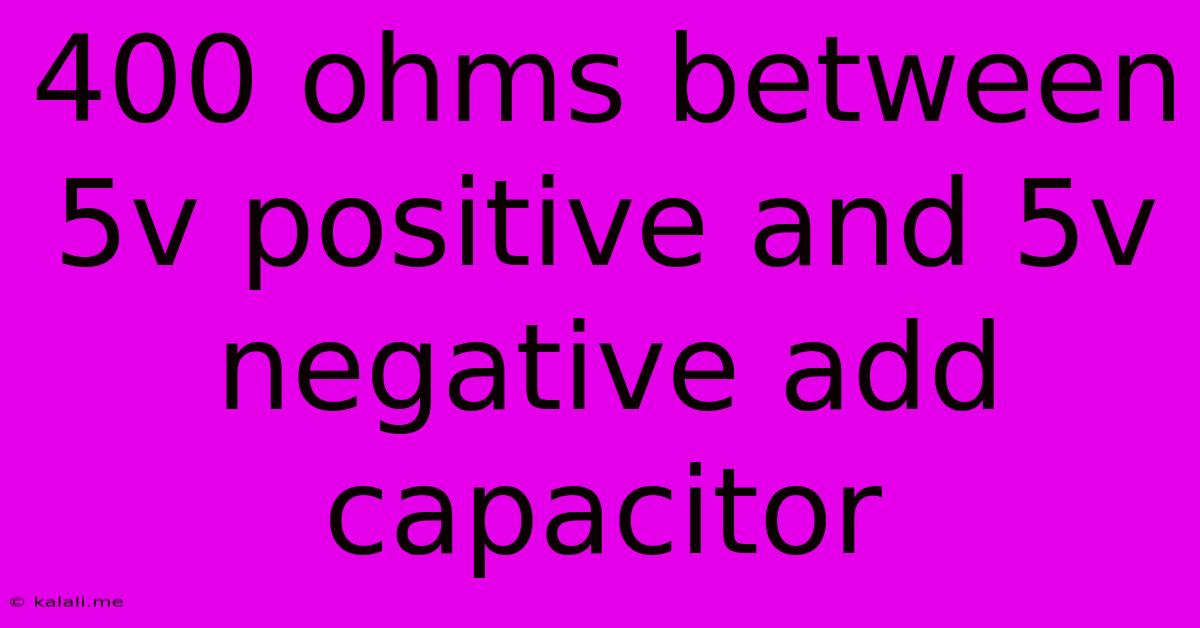400 Ohms Between 5v Positive And 5v Negative Add Capacitor
Kalali
Jun 04, 2025 · 3 min read

Table of Contents
Understanding the 400 Ohm Resistor and Capacitor Combination Between 5V Positive and 5V Negative
Adding a 400-ohm resistor and a capacitor between the positive and negative 5V rails might seem unusual, as it appears to short-circuit the power supply. However, this configuration isn't a simple short. It's used in specific circumstances, primarily for noise suppression and power supply filtering. This article will delve into the function, applications, and considerations of such a setup. Understanding this circuit requires a basic grasp of electronics, specifically resistors, capacitors, and their behavior in AC and DC circuits.
What's Happening?
A DC voltage, such as a 5V supply, provides a constant potential difference. The 400-ohm resistor limits the current flowing between the positive and negative rails. This is crucial, as a direct short would cause a significant current surge, potentially damaging the power supply or other components. The capacitor, on the other hand, acts as a filter.
-
DC Blocking: The capacitor blocks direct current (DC). This means the constant 5V supply is effectively blocked by the capacitor. Hence, it won't short the power rails directly in a stable DC context.
-
AC Filtering: However, the capacitor allows alternating current (AC) to pass. High-frequency noise, which is essentially AC, is often present in power supplies and circuits. The capacitor acts as a bypass, shunting this noise to ground, preventing it from affecting sensitive components. The resistor limits the current to a safe level, protecting the capacitor from excessive current flow.
Why Use This Configuration?
Several scenarios necessitate this type of noise reduction strategy.
-
Sensitive Analog Circuits: Analog circuits, particularly those using operational amplifiers (op-amps) or other sensitive components, are vulnerable to high-frequency noise. This noise can introduce errors and instability. The resistor-capacitor (RC) filter helps maintain signal integrity.
-
Microcontroller Applications: Microcontrollers often need a clean power supply to avoid glitches or malfunctions. Small fluctuations in voltage can cause unexpected behavior. An RC filter on the power lines improves stability and reliability.
-
RF Circuits: In radio frequency (RF) circuits, unwanted noise can significantly impact performance. Filtering the power supply with an RC network contributes to cleaner RF signals.
Choosing Component Values
The values of the resistor and capacitor are crucial. The 400-ohm resistor is relatively low, suggesting the intention is to filter higher frequencies while still allowing a small amount of current flow. A higher resistance value would filter out more noise but could also reduce the availability of current to the circuit.
The capacitance value isn't specified, and this is a critical omission. The appropriate capacitance depends on the frequencies of noise being suppressed. A larger capacitance will filter lower frequencies more effectively. The frequency response is determined by the RC time constant, calculated as:
τ = R * C
where τ is the time constant in seconds, R is the resistance in ohms, and C is the capacitance in farads. A smaller time constant means the filter will be more effective at higher frequencies.
Potential Drawbacks
-
Power Dissipation: The resistor will dissipate some power, generating heat. The power dissipation (P) can be calculated using the formula: P = I² * R, where I is the current flowing through the resistor. The heat generated is usually minimal with a 400-ohm resistor in this context.
-
Improper Component Selection: Selecting incorrect values for the resistor and capacitor can lead to insufficient noise suppression or even damage to the components.
Conclusion:
A 400-ohm resistor and capacitor network between the 5V positive and negative rails serves as a simple but effective noise filter. Its effectiveness depends on choosing the correct capacitor value based on the specific noise characteristics of the circuit. Always prioritize safety and correctly choose the components based on the circuit's requirements to prevent damage or unexpected behavior. This setup is particularly valuable in sensitive applications where noise reduction is paramount. Remember to always consult datasheets and relevant literature for precise component selection.
Latest Posts
Latest Posts
-
Water Based Urethane Over Oil Based Stain
Jun 06, 2025
-
Steam Too Many Purchase Attempts Cooldown
Jun 06, 2025
-
How Old Was Rebekah When She Met Isaac
Jun 06, 2025
-
Does Not Sleeping Change Your Special Falloiut 4
Jun 06, 2025
-
Blender 4 How To Save Pose
Jun 06, 2025
Related Post
Thank you for visiting our website which covers about 400 Ohms Between 5v Positive And 5v Negative Add Capacitor . We hope the information provided has been useful to you. Feel free to contact us if you have any questions or need further assistance. See you next time and don't miss to bookmark.